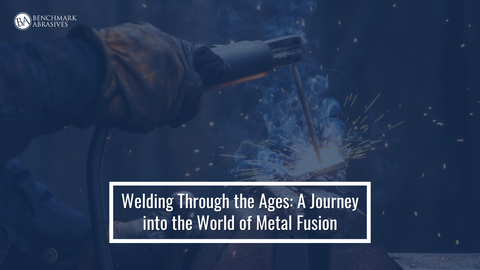
Welding Through The Ages: A Journey into The World Of Metal Fusion

HISTORY OF WELDING - AN OVERVIEW
One of the most important milestones in the evolution of modern society and metal fabrication is the creation and technological production of welding. Welding's history spans millennia, with notable advancements occurring on numerous continents. The first method humans used to join metals was welding, which allowed for the creation of jewelry, weapons, transportation, and other items.
WELDING DURING THE PERIODS OF IRON AND BRONZE
Welding has existed since humans first began working with bronze in approximately 3000 B.C. Tiny golden boxes from the Bronze Age, which occurred more than 2,000 years ago, are the earliest known instances of welding. Archaeologists have discovered weaponry, jewelry, and dining utensils from this era. Egyptians began pressure-welding swords with charcoal in 3000 B.C., and iron smelting became more widespread in 1500 B.C.
Iron Age weapons and artifacts, manufactured around 1000 B.C., have been discovered throughout the Middle East. For centuries, welders have fused metals such as copper, bronze, silver, gold, and iron. Then, when metalworking developed, steel was welded.
During the Sui Dynasty, Chinese metalworkers learned how to transform iron into steel in 589 A.D.. About the same period, Japanese metalworkers forged and welded steel to create Samurai swords.
THE MIDDLE AGES OF WELDING
With the invention of blacksmithing throughout the Middle Ages, iron became a readily available material for creating welded metal artifacts. In particular, forge welding advanced during the Middle Ages and is still used by contemporary blacksmiths to make blades and swords.
The first printed book on metallurgy, De la Pirotechnia, was written in 1540 by the Italian metallurgist Vannoccio Biringuccio and contained instructions on forging and smelting iron. Throughout the Renaissance, forge welding and blacksmithing both expanded.
A common practice in the Middle Ages was for blacksmiths, also known as smithies, to locate their businesses in the heart of their communities. Blacksmiths created armor, locks, horseshoes, nails, furniture, and forging and welding weapons. Blacksmiths were vital to every community because of their practical ability to provide tools for defense, transportation, household products, and other purposes.
THE 19TH AND 20TH CENTURIES SAW WELDING
Modern welding techniques were created during the Industrial Revolution. Chemist Sir Humphry Davy made the 1800 discovery of how to create an arc between two carbon electrodes with a battery. The steady electric arc, invented by Russian scientist Vasily Petrov in 1802, allowed metalworkers to melt metal. The discovery of acetylene is credited to Edmund Davy, Humphry Davy's cousin, in 1836. In the middle of the 19th century, these findings led to the creation of the electric generator, gas welding and cutting, and more reliable arc welding.
Welding usage increased significantly during World War I due to advancements in global transportation and weaponry manufacture. In England and Germany, arc welding was widely used to construct ships and aircraft. In 1920, automatic welding was introduced, in which the welding equipment continually feeds an electrode wire. In the 1900s, new welding glasses were also employed to shield welds from the effects of atmospheric nitrogen and oxygen, thereby averting brittle and rusty welds.
Many innovative welding techniques, such as underwater and stud welding, were developed in the middle of the 20th century. After decades of development, gas tungsten arc welding became more popular and safer in 1941, enabling welders to fuse various nonferrous metals.
MODERN-DAY WELDING
Welding has advanced greatly over thousands of years of technological and practical advancements to become more precise, quick, and efficient. Over 90 welding procedures are currently in use, and fresh research in the nuclear, space, transportation, and shipbuilding industries is constantly developing these techniques.
Modern welding methods have developed to provide superior results, with a foundation in sustainability and safe construction. Modern inspection methods have enhanced flaws or inconsistencies, raising the bar for workmanship and safety.
Several certificates and licenses are available if you're interested in a welding career, and some businesses could demand them. The American Welding Society (AWS) is responsible for setting the current benchmark for the welding industry in the country. AWS-certified welders based on their qualifications, job experience, and ability to weld particular tests.
DEVELOPMENTS IN WELDING TOOLS AND MATERIALS
The advancement of welding technology encompasses more than just methods and procedures. Technological developments in equipment and materials have greatly impacted the industry. The effectiveness and quality of welding have increased with the development of novel welding consumables such as flux-cored wires and sophisticated shielding glasses. These consumables offer improved protection against flaws and better welding process control.
Advancements in welding electrodes, equipment, and consumables have aided the business's progress. Modern welding equipment can precisely manage welding conditions using sophisticated features like digital controls and inverter technology. These devices provide higher overall performance, enhanced arc stability, and increased energy economy.
ROBOTICS AND AUTOMATION IN WELDING
The welding industry has transformed in recent years due to incorporation of automation and robotics. Sophisticated robotic welding devices can complete intricate welding jobs with little human assistance. These systems are perfect for high-volume production environments because they provide increased precision, consistency, and speed.
Automation and robotics have increased workplace safety and welding process efficiency. Robotic welding systems lower the risk of injuries and foster a safer work environment by doing repetitive and potentially dangerous jobs for human welders.
CONCLUSION
The development of welding technology has been characterized by notable breakthroughs and advances. From its early beginnings, welding has been essential in forming industries and advancing society.
Keeping up with the most recent welding techniques, technologies, and materials in this constantly changing field is critical. By embracing innovation and investing in training and education, industries can take full advantage of welding technology and propel advancements in the manufacturing industry. Welding technology has a long way to go, and there is a virtually endless amount of work ahead.



































































